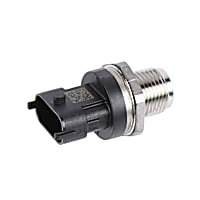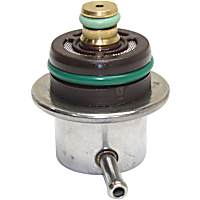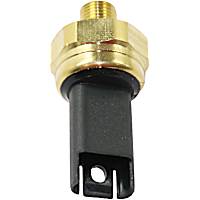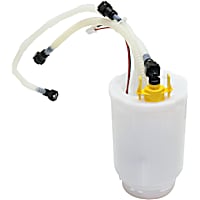On-board diagnostic (OBD) systems help vehicle owners identify potential problems perceived by their car’s primary computer. In many cases, an illuminated check engine light will alert you of an error logged in this system. To retrieve the specific trouble code, you’ll need to connect a scan tool or code reader to your vehicle’s OBD port.
One common fault code you may come across is P0088. Read on to learn more about code P0088, its causes, and the common symptoms associated with it.
What Does the P0088 Code Mean?
Diagnostic trouble code (DTC) P0088 stands for “Fuel Rail/System Pressure – Too High.” It is set when the powertrain control module (PCM) perceives a fuel rail pressure or fuel pressure sensor voltage input that may be higher than the set specifications.

The PCM monitors the fuel pressure and makes adjustments as necessary to maintain the desired fuel pressure and keep the engine running. If the PCM detects that the fuel pressure may be too high, it will log code P0088. This code is commonly found in diesel-powered vehicles that have common rail fuel injection.
Depending on the severity, other trouble codes may also be logged. As it is a similar code to P0088, error code P0087 may also be logged.
A thorough understanding of common rail fuel injection systems could help you fix P0088 if you’re planning a DIY solution. You can read our technical discussion about common rail fuel injection and OBD codes. If you want to quickly learn the possible causes of this code, continue reading the next section.
Note: The definition of code P0088 may be different depending on the vehicle manufacturer. Consult the appropriate repair manual or repair database for the exact code definition.
What are the Possible Causes of the P0088 Code?
P0088 is a generic code, so it can have many potential triggers. Here are the most common:
- Failed fuel pressure regulator or fuel control valve/actuator
- Faulty fuel pump
- A restriction in the fuel system
- Defective fuel rail pressure sensor
- Wiring issues
- Faulty PCM or software in need of an update

What are the Common Symptoms of the P0088 Code?
You may notice the following symptoms if your car has a stored P0088 trouble code:
- Illuminated check engine light
- Poor engine performance/ engine stalling
- Poor fuel economy
- Thick, black exhaust exiting the exhaust system
How to Diagnose the P0088 Code
Pinpointing the underlying cause of the P0088 fault code can be tricky, especially without the tools or expertise of a mechanic. As a rule of thumb, always follow the diagnostic procedure specified by your vehicle’s manufacturer. This is because the process may vary per vehicle. A code P0088 on a Ford may have different diagnostic steps from a code P0088 on a Toyota.
However, if you’re not well-versed in auto repair, it would be best to bring your vehicle to an auto repair shop for an accurate diagnosis.
How to Fix the P0088 Code
P0088 may share similar triggers and symptoms with other fault codes. However, that does not mean that they share repair steps as well. All vehicles are different, so make sure to refer to a factory repair guide that is specific to your car.

If you’re an advanced DIYer who’d like to fix this code on your own, it will be helpful to refer to your vehicle’s repair manual or get factory vehicle repair information from an online database. But if you’re not confident in your automotive skills, it would be best to leave this job to a professional.
Common Rail Fuel Injection and P0088
This is a code only listed on vehicles that use “common rail” fuel injection (CRI). The fuel rail has a feedback sensor that the ECM uses to determine what needs to be done with the High Pressure Pump solenoid in order to meet the necessary pressure target. In the case of this P0088 code, the measured pressure is higher than the target. Of course, it could also be a problem with the fuel rail pressure (FRP) sensor over-reporting the pressure.
On common rail platforms (GDI Gasoline or CRI Diesel), there’s always a solenoid on the high pressure fuel pump that the ECM/PCM uses to control pump output pressure. Some of these default to high pressure when the solenoid circuit is open; others default to low pressure.
A high pressure default pressure control solenoid could cause this code due to an open circuit within the solenoid (which would cause the pressure to be higher than the ECM’s target), but a low pressure default solenoid could cause this due to a wiring issue.
Of course, if there were issues with the solenoid circuit there would be a code stored for that issue as well.
Suffice to say that if the ECM’s target is lower than the pressure for a given period of time, code P0088 will set.
Remember though, on GDI engines, the camshaft sensor is used by the ECM to determine which pump stroke is happening (up or down) and that’s factored into the duty cycle sent to the pump solenoid for efficient pressure control. Thus, if the timing belt or chain is off a few teeth it can cause an issue like this, too.
For more technical information on common rail fuel injection systems, read our discussion here.
NOTE: If any of the fuel supply lines or the fuel rail pressure sensor are removed on a common rail system, the component must be replaced, so don’t remove a line or a sensor unless you have a new one with which to replace it. The soft iron seat will only seal once.
Also, to avoid severe injury, don’t remove any fuel line unless you know for sure there’s no pressure in the rail.
Fixing DTC P0088 By Replacing Faulty Parts
DTC P0088 is often logged when certain components malfunction. This code is typically logged when the fuel pressure regulator, fuel control valve, or fuel pump fails. Once you’ve pinpointed which of these parts is the culprit, don’t put off replacing it. For top-notch replacement parts that give you the best value for your money, shop here at CarParts.com.
Our website makes it easy for car owners like you to find the right parts for your ride. Use our vehicle selector to start shopping, and funnel the catalog results according to your preferred brand, price, and specs using the search filters.
Find only the best prices when you shop from us. All our products come with a low-price and lifetime replacement guarantee, helping you get the best value for your money.
We make sure to get our auto parts from the most trusted manufacturers in the industry. All our parts pass the highest quality control standards from industry professionals, so you won’t have to worry about any replacements you order failing you any time soon.
Don’t let your vehicle gather dust in your driveway because of faulty parts. Shop for the parts you need today!
Products Mentioned in this Guide
Any information provided on this Website is for informational purposes only and is not intended to replace consultation with a professional mechanic. The accuracy and timeliness of the information may change from the time of publication.

 Fuel Rail Pressure Sensor
Fuel Rail Pressure Sensor
 Fuel Pressure Regulator
Fuel Pressure Regulator
 Fuel Pressure Sensor
Fuel Pressure Sensor
 Fuel Pump
Fuel Pump














